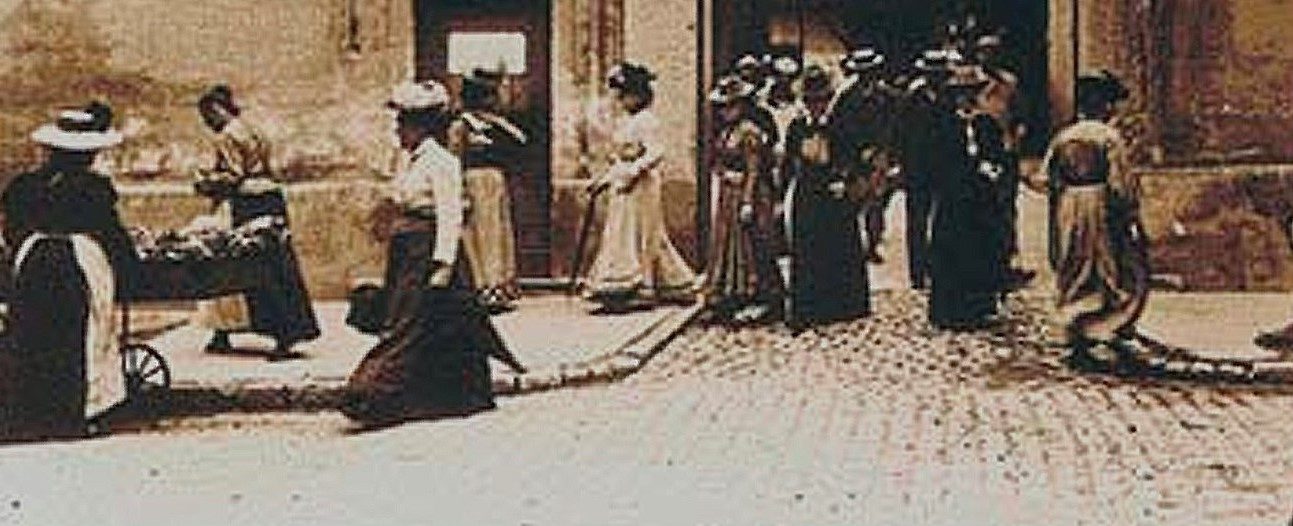Portugal, 1963
Directed by Manoel de Oliveira
With Nicolau Nunes Da Silva (the Christ), Ermelinda Pires (Mary), Luis De Sousa (the Accusing Soldier), Francisco Luís (Pilates), Germano Careiro (Judas)

While traveling in the Trás-os-Montes e Aldo Douro province to shoot a documentary, Manoel de Oliveira saw three crosses on a hill and wondered what significance they held. What he found out was an act of folksy devotion whose age and manner was astonishing. The inhabitants of the village of Curahla had kept a tradition of representing the Passion of the Christ since the 16th century according to a text written at this time by Francisco Vaz de Guimarães. This is called the acto da primavera, or the act of the spring. De Oliveira decided to film this odd form of belief that felt like a faraway offshoot of the medieval mystery plays of France or England.
The sheer scale of the theatrical performance is outstanding. It involves most of the villagers, each one having her or his part, big or small, clearly assigned and seriously learned, and the performance feels like a part of their life as important and self-evident as their farming tasks. The stage is no less than the whole countryside place, to the farthest hill to the closest well, and the peasants-turned-actors move around with their costumes on and telling their lines in the same natural manner as they would busy themselves in the fields. Each steps of the well-known drama is carefully represented, from the arrival to Jerusalem to the Descent from the cross. If most actors just say their texts, a few tend to incant them, especially the Christ; it makes for a surprising but haunting performance that is not unlike a Gregorian chant and gives the text a deep-felt and mystical tinge.
De Oliveira’s aim in “O acto da primavera – Rite of Spring” seems to record this annual transformation of a village into a theater in the name of faith as it happens and he makes this point clear at one moment (in a move that has nothing to do with the neutral viewpoint documentary-makers vow to espouse). The performance is cut by pictures showing the director and his crew at work along with a few people, obviously from the cities, who have stumbled on the event while on a day trip and now wonder what it could bring to them – a young lady fears getting bored while her intellectual male companion hopes for some fun. But this is more than a documentary and the actors are anything but boring or amusing.
De Oliveira deftly follows the villagers from the start as their fictional characters quietly come into life among them without a break in the continuity of their life. The first pictures show a group of villagers listening to one of them as he reads aloud the news from a Lisbon paper before posters are stuck on the walls announcing the act of spring. Then the camera focuses on a young woman getting ready for her part; she gets out of her house, walks to a well and answers a call by Jesus; the play is on. Compositions and editing choices increasingly emphasize the intense and serious rendition of their roles by the villagers and the film is no longer about believers putting on a representation but tracks real performers giving life to their characters. The cobbled-together nature of the props and costumes, so clearly indicated and so amusing, fades into the dynamics of an essential story.
The true end of the Passion is not filmed – but then, how can you shoot a resurrection? Instead, the director asserts his vision by showing an unexpected and distressing montage of news footage recording the Vietnam War and World War Two. The Christ died to redeem the mankind after preaching brotherhood and hope; the villagers, like other true believers, want to experience again His journey and pain to support His word; but the way of the world is clearly oblivious to the sacrifice and bound to destruction. Modernity is no help.
It is funny that the villager first reading aloud the news focuses his attention to a report on space conquest; once the play is over, during which he has played the part of the Accusing Soldier tormenting Jesus and bringing him to the authorities (the Sanhedrin, Pontius Pilate and Herod Antipas), he picks up again his role of news reader and comes back to the same topic; but he is interrupted by a fellow announcing the Resurrection. Man can go to space but that doesn’t bring any solution to the problems in store on Earth, including the poverty of the average Portuguese village. Faith remains a key element of our aspirations and traditions still make sense. On another level, the film trajectory of this peasant, alternatively a reader and a soldier, shows how much de Oliveira has worked on the material he discovered perchance to build his own vision that strays from the rules of the documentary and create a unique storytelling that magnifies and colors an original performance.
The film is the product of a deeply personal and uncompromising cinematic vision that plays with the forms and the power of representation to give the audience a fresh look at the state of the world.

